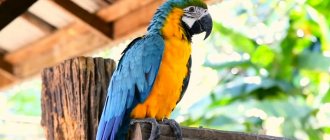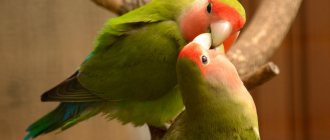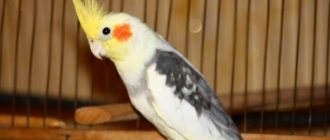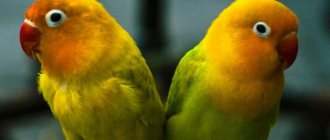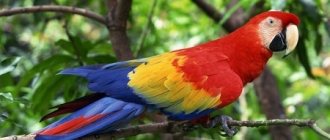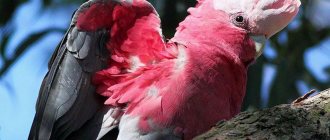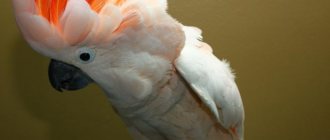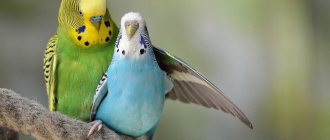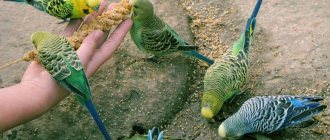— The Indian ringed parrot, or, as it is also called, the ringed parrot, is in great demand and popularity in comparison with other species of its family, and attracts the attention of many. In total, there are 12 species in the genus of these birds. The necklace parrot is quite unpretentious in care and maintenance. This is why it has been attractive to people from antiquity to the present day.
General information about the breed
This bird species was first discovered in Asia and Africa. Nests are made exclusively high above the ground in the treetops to protect themselves. They fall to the ground in rare cases. During the day, while it is light, parrots sit in their nests and hollows, and in the evening, when it begins to get dark, they get out of their hiding place and go in search of food. In flocks they can raid pastures and arable lands, thereby causing some damage to humans.
Appearance
The necklace parrot attracts the attention of those around it with its bright, emerald-colored plumage, which has a soft blue tint at the back of its head. There are brownish spots on the upper part of the bird's wings, and its beak is colored red. A distinctive feature of the bird is the so-called “necklace” - a surrounding black stripe on its neck, turning into a pink stripe at the top.
Appearance characteristics:
- The body length of parrots is about 50 cm;
- a necklace and bright color are observed only in males over 3 years of age;
- in females, the plumage is paler in color, and the stripe on the neck is completely absent;
- chicks also have a dull color, but as they grow older and depending on gender, the color either becomes more saturated or remains dull in tone.
You can see what a necklace parrot looks like in the photo:
Character
The necklace parrot has a good-natured, gentle character; these birds will delight their owner with playfulness and grace. This pet easily adapts to home conditions and quickly makes contact with people. Birds are quite smart, so they can be trained without much difficulty. If you find the right approach to them, you can even wean them off loud screams.
Ringed parrots practically do not cause any inconvenience to their owners. To be able to build a friendly relationship with your pet and teach it to talk, you need to take a chick at least 7 weeks old. You can determine their gender by their behavior: at the age of up to 3 years, the female and the male are quite similar in appearance, however, if you bring a mirror to the second one, he will squint his eyes, slightly open his mouth and spread his wings.
Varieties
As mentioned above, there are about 12 species of parrots belonging to the ringed genus:
- Kramer;
- pink-headed;
- Alexandrov;
- threadtail;
- Himalayan;
- rose-breasted;
- grey-headed;
- emerald;
- plum-headed;
- Mauritian;
- Malabar;
- Chinese.
Lifespan
With good and high-quality maintenance, care, and a balanced diet, these birds can live about 15 years. There have been some cases where the necklace parrot has reached 40 years of age.
History of domestication
The first to teach ringed birds human speech were the Indians, who believed that every self-respecting person should have taught at least one parrot to speak humanly throughout his life. The European population first learned about these birds during the period of the conquests of Alexander the Great. Upon his return from India, the military leader Onesicritus brought a pair of tame birds to Greece.
Much later, the German naturalist Wilhelm Kramer began studying this species of bird. That is why these birds are also called Kramer's parrots.
Possible causes of early death
Despite the average life expectancy, it can be shortened by invasive and infectious diseases, injuries and vitamin deficiency, which occurs in birds with a poor diet. It is difficult to determine which vitamin a parrot lacks. Therefore, if there is a change in behavior or appearance, an urgent visit to the veterinarian is necessary.
Any disease in birds is manifested by lethargy and apathy. Such parrots sit mainly in one place. Other symptoms may also occur:
- lack of appetite;
- hard breath;
- drowsiness;
- peeling of the skin;
- change in stool color;
- discharge from the eyes or beak;
- coughing attacks;
- temperature increase;
- disruption of the gastrointestinal tract.
Important! Feather plucking is a common sign of extreme stress and physical pain.
Eating poisonous plants also leads to early death of the necklace parrot:
- azaleas;
- begonias;
- monsters;
- fern;
- oleander.
Preparation
Before purchasing a parrot, you should prepare its home. Of course, a cage is suitable as housing. However, to make the bird feel more comfortable indoors, you can create a special corner, the so-called “sports” corner, where it could climb various perches, artificial branches, etc. Such a corner should be equipped away from drafts.
Microclimate in the apartment
Despite the unpretentiousness of a feathered pet, there are still certain requirements for the microclimate:
- The room temperature should be from 15 degrees, no less. Although ringed parrots tolerate cool weather well, they are still more comfortable in warmth;
- air humidity - from 60% to 70%;
- The parrot's wakefulness should not exceed 12 hours; the rest of the time it should spend sleeping, in complete darkness. To do this, you need to turn off the lights in the room or artificially create darkness using a cloth draped over the cage.
Safety
The first thing to remember is that open windows are a direct threat to your pet’s health. Therefore, the best way to keep your bird safe and out of trouble is to keep the windows closed when the parrot is free.
The second thing to remember is the danger that electrical wires and sockets pose to birds. A parrot can easily chew through a live wire or break a socket. Therefore, if all the wires are on the surface, they should be placed in special boxes.
Various small parts containing lead or zinc can also pose a threat to the pet’s life. If a bird swallows even a small thing containing a dangerous metal, the poisoning will make itself felt within a couple of hours.
Cage requirements
As for the cell, it must meet certain requirements:
- the location of the cage should be such that the topmost perch, on which the bird will sit almost all the time, is at eye level or slightly lower;
- It is better that the stand under the cage has wheels;
- Feeders should be purchased from durable, high-quality plastic, and they must be securely fastened to the bars of the cage;
- the bird's house should be located away from drafts, so placing it in the aisle is not the best option;
- The height of the cage is at least 0.7 m, and the width is 0.5 m.
Equipment
Equipment in the cage should include perches, a sippy cup and a feeder. Your pet may get bored of sitting idle in a cage all the time; to avoid this, you should place various toys, small mirrors or bells in the cage.
How long does a necklace parrot live?
The lifespan of any pet directly depends on the care and attention you give. Parrots are no exception. Cramer's ringed parrot (Indian ringed parrot) lives 20-30 years in ideal conditions. At the same time, the dangers that await him in an ordinary apartment may not be obvious to you. Most often, birds die for the following reasons:
- due to illness and lack of medical care;
- from poisoning with inappropriate food;
- after hitting a window glass or mirror;
- from electric shock if the parrot damages the wire;
- the pet flew out the window - the chance that it will survive on the street is close to zero.
The life of a pet cannot be left to chance. You need to monitor his health, follow the rules of nutrition, and not leave him alone after letting him out of the cage.
Buying a bird
Where can I buy
You can buy a necklace parrot in a specialized nursery or in an ordinary pet store (which cannot be said, for example, about a gray parrot, which can only be purchased from breeders).
What to consider when purchasing
Before you buy a feathered pet, if you want to teach the bird to speak, you should consider some factors:
- The parrot should be purchased while still a chick (about 7 weeks old);
- It's worth buying only one individual.
If you buy an already grown pet, then the most that it can do is imitate sounds. If he has a couple, he will hardly be able to concentrate on learning. By taking into account just these two points, you can teach your feathered friend to speak up to 60 words.
Who is better for home keeping: male or female?
It is quite difficult to determine who is better to purchase as a feathered friend: a female or a male. Here everyone relies on their own taste and requirements for a parrot.
However, you should be aware of the differences in behavior between females and males:
- the male is more active, playful, easier and faster to train;
- the female has a more docile and calm character.
Price
The necklace parrot is a rather expensive bird species: the price for one chick starts from 9 thousand rubles.
Who is our male? A little experiment
To understand who is in front of you - a boy or a girl, conduct an experiment with a bird. Even before the characteristic ring around the neck begins to appear, males and females sometimes “give up” themselves. Bring the bird to the mirror. The male will slightly open his wings, they will resemble a heart shape, his pupils will narrow. Females don’t do this, because they have no need to demonstrate “male strength.” But already from 12 months they cackle, throwing back their heads.
When two parrots of different sexes are kept together, females often behave more aggressively towards their neighbor than males. This is normal for necklaces, but in especially severe cases the owner’s help may be needed: the birds are placed in different cages, or in a spacious enclosure, where everyone will have enough territory.
If you found our article useful, be sure to like it and share it with your friends. Tell us about your impressions or about your pet in the comments; it will definitely be useful to other readers.
Maintenance and care
Bathing
These birds love water very much. There are three ways to bathe them:
- Using a spray bottle, spray your pet. You can do this daily.
- Two or three times a week, a small container filled with warm water should be placed in the bird’s “house”. Your pet can frolic to his heart's content in it.
- If the bird is tame, you can hold it in your hands under a stream of tap water.
Flying
Flight is very important for tame birds, as they lead an active lifestyle. Already sufficiently mature chicks should be released about 3-4 times a week, if the cage is small - then daily. The duration of such flights is from half an hour to 2-3 hours.
To keep your pet safe in flight, the following should be observed:
- isolate other pets (cats, dogs) during the flight;
- keep windows closed.
Cleaning the cage
Cleaning the cage takes place in several stages:
- Rinsing and drying drinking bowls and feeders daily (rinse with warm water and let them dry).
- Cleaning toys and the “sports” corner twice a week (from droppings, feathers and dust).
- Rinse the baths once a week.
- Monthly general cleaning. Complete cleaning and cleaning of the cage is done using a special solution. After cleaning, before putting your pet in, the cage needs to be ventilated.
Reviews
Alexandra Egorova, 19 years old, Voronezh
Before, I could never think of having a pet in my apartment. As a child, like all children, I brought kittens and puppies from the street, but they did not stay with us for more than one day - my parents were against it. How happy I was when they gave me a charming parrot for my coming of age! He has a beautiful collar around his neck, or rather a black necklace. That's probably why it got its name. I started dreaming about how he would talk to me, fly around the apartment...
It turned out that everything was exactly the opposite. Joseph (yes, that’s what I called him) turned out to be very calm, practically did not fly, but rather wandered around the cage, so we soon got him a larger home. I noticed that he doesn’t just play with fruits and his toys, but tries to understand and understand. It was not possible for me to teach Joseph to speak like that, and it is unlikely that parrots of this breed are capable of this, but we always have fun with him. This is a miracle, not a bird!
Dmitry Sergeevich, 48 years old, Biysk
I gave my daughter a necklace parrot for her graduation from school. My daughter lived separately, with her mother, and I had to keep the parrot at home for a month after the purchase. At this time I tried to determine his habits and train him a little. They say that necklace parrots are the least trainable, but I managed to teach him to do some exercises. I bought toys for the cage: cubes and other wooden crafts. It is important that the material does not irritate your ears when the parrot runs its beak over it, so metal is definitely not suitable for its pleasures.
The parrot lived with my daughter for no more than two months - then she unexpectedly left to study in the capital, and the bird again moved to permanent residence with me. It’s immediately obvious how Masha spoiled him: the parrot began to make screams and crackling noises. Over the next weeks, I retrained him: I spoke to him in a quiet voice, tried to keep the apartment quiet and quiet. Now I can definitely say that my pet is the quietest and most docile bird!
Anipa Maksudovna, 40 years old, Kazan
The parrots Yasha and Yana are my best and probably only friends now. Oh, it took me a lot of effort to raise them! First, at the pet store I bought one necklace parrot Yasha: this is a beautiful yellow-green bird with a necklace on its neck. Yasha was almost always calm and at night he was almost never heard, at most - the sound of his beak or claws on the cage. By the way, despite the fact that parrots usually love to fly, this one prefers to wander around the table.
With the advent of Yana, everything changed! At first, I wasn’t even sure that Yana was the same breed, since she didn’t have the so-called “necklace”. But then I became convinced that it only occurs in males. Yana is very noisy and restless. There is not a single centimeter of wallpaper that does not know Yana’s beak: she tears everything she sees with her beak. And in the cage she behaves more carelessly than Yasha. I don’t know if I should expect small parrots, but despite all the difficulties in caring for them, I would keep them, because parrots are just those living creatures that can cheer up.
Mark Zakharovich, 36 years old, Sochi
Before buying a parrot, I was sure that my wife and I had one child. It turned out that the parrot, without exaggeration, also became our little family member. We bought the necklace one because it immediately caught our son's attention with its bright coloring. The females are not as beautiful as the male, and he is less of a hassle to keep. By the way, my son named the parrot Arnold - that’s the name of the hero of his favorite cartoon.
All the fun started after Arnold spoke. By that time he was already quite old, although we took him in when he was two months old. My wife, son and I talked with him, rehearsed, so to speak, replenished the vocabulary with exclusively decent words. Imagine our surprise when one day my wife and I confused and mistook Arnold’s so-called conversation for his son’s speech. My little son is 7 years old, and parrots, it turns out, often have the voice of a child 7-9 years old. And Arnold behaves no better than a child: he loves toys, and because he uses his claws and beak while playing, he often has to buy new ones. But he doesn’t spoil our things, although we often let him out of his cage to fly around the room. He amuses us a lot, and without exaggeration I can say that without Arnold there would be less happiness in our family.
Veronika Nikolaevna, 43 years old, Ekaterinburg
A red-necked parakeet has been living in our dacha for over a year now. This is not our first pet - before this we had wavy ones, but the necklace one seemed more interesting to me. I myself am a veterinarian and know a lot about caring for animals, so it was not difficult for me to take care of this bird. The parrot is not picky about food: he eats everything I give him. Sometimes he doesn’t just eat, but moves his paws as if trying to count. He categorically does not like it when someone tries to pick him up. Tries to bite to escape. He bit my husband several times until he bled, but never me yet. However, the parrot loves to be fed from hands: it willingly takes food and does not try to bite at this moment.
Nutrition
Feed selection
Currently, pet stores offer a wide range of different foods for feathered pets.
Below is a list of some brands of feed:
- RIO food: its manufacturer is the company This company develops and produces food for all types of parrots. It has been on the market for about 20 years and positions itself as a quality product at an affordable price.
- WAKA feed: the manufacturer of this feed, established in 1991. This company produces grain mixtures of various qualities and different prices: from elite to cheap products. WAKA food is quite popular among owners of tame birds, perhaps due to its rather low prices. However, you can also find negative feedback on the forums.
- CHIKA food: the company producing this food was founded in 1994. These grain mixtures are among the most affordable. However, based on surveys conducted on various websites, this food is relatively unpopular among consumers.
Mineral and vitamin mixtures
The approximate composition of the mineral-vitamin feed mixture for the necklace parrot should be as follows:
- hemp;
- porridge (rice, buckwheat, millet);
- cottage cheese;
- oats or oatmeal;
- crushed corn kernels;
- finely chopped chicken egg;
- crumb of white bread;
- grated carrots;
- calcium gluconate;
- pieces of apple, pear;
- glucose.
Favorite treats
The feathered pet will happily enjoy the treats that the owner offers him. However, caution should be exercised in this regard. After all, tame birds cannot eat everything.
Suitable treats:
- boiled sweet corn;
- walnuts, almonds, peanuts;
- sprouted wheat.
Occasionally, your feathered friend can be given oatmeal porridge, hard-boiled eggs, vegetables and fruits, and the inside of bread.
Approximate diet
The bird's daily menu should consist of the following components: listed below.
Components:
- 25% oats or oatmeal;
- about 7% vegetables (necessarily fresh);
- 10-15% sunflower seeds;
- 15% canary mixture;
- 35% cereals (millet).
One parrot should eat about 30 grams of this healthy mixture, no less, and mineral supplements should also be added to the diet.
Prohibited Products
Poultry, as mentioned above, cannot eat everything. Therefore, every owner should know which foods are prohibited for parrots.
Prohibited products are:
- papaya;
- mango;
- avocado;
- persimmon;
- garlic, sorrel, dill, onion. parsley (not recommended);
- frozen fruits or vegetables;
- cream, sour cream and milk.
How long does a necklace parrot live and how to determine its age - SPELLING
Necklace parrots or, as they are also called, Kramer's parrots, are among the most capricious and freedom-loving species of parrots. Kramer's parrots are distinguished by their good adaptability to various living conditions and ease of care. These characteristics make necklace parakeets very attractive for home keeping. Of course, everyone who wants to get such a bird or who already owns a feathered pet is interested in how long the parrot will be around. How long necklace parrots live and how to determine the age of a bird will be discussed in the article.
Reproduction
Breeding of necklace parrots is much more successful in comparison with other species of this genus if they are kept in an aviary about 2 meters long in pairs. At the beginning of the mating season, the male fluffs his tail and begins to fly around the female, making rather pleasant sounds.
As a nest for parrots, you need to build a house (30cm x 30cm x 50cm), with a small hole with a diameter of 7cm.
In order for bird eggs to develop well, they need moisture. To increase air humidity, sawdust with moistened peat is placed at the bottom of the “nest” and compacted well. The female lays about 3-5 eggs. She incubates them for 22-23 days.
Young chicks leave the nest only 6 days after they hatch, but for the next 2-3 weeks their parents continue to care for them. Their color is similar to that of the female, only after 3 years their plumage turns into the color of adults.
How to determine gender
It is extremely difficult to determine the sex of a bird before 3 years of age, since the female and male have approximately the same plumage color. Not even all ornithologists are able to cope with this task. However, by the age of 3, sexual characteristics are evident: the male has a pink necklace and the color becomes brighter. The female remains with a more faded plumage, without a necklace.
True signs of gender
From the age of three, males and females begin to look different: boys acquire their bright colors. But the most important sign of gender appears earlier: the characteristic “necklace” - a ring of dark feathers on the neck - begins to appear at 14-17 months. In front and on the sides it is wide, black, in the back it is pink.
Females remain with the “juvenile” colors, which are duller and without the black “necklace.” Their neck is decorated only with a small greenish ring.
Females have stronger legs and a stockier body. The beak seems smaller against the background of the rounded head (in boys it is flatter), the tail is shorter than the “male” one, and in Indian ringtails the back is more blue.
Female red-ringed parrots have a gray head, yellow-green underparts, and a red beak. Rose-breasted ringeds can be distinguished by their beak: in males it is black only at the bottom, in females it is completely black. Female emerald ringeds are identified by their black beak (in males it is red).
Education and training
Taming and communication
Before you begin training, you should tame the necklace parrot.
To do this you need to follow simple steps:
- be present next to the pet during its meal, so that it can eat food without fear in the presence of its owner;
- teach your pet to take treats from your hands. To do this, you can stretch your favorite treat through the bars of the cage and hold it for a while. At first the parrot will be afraid to approach, but after a while he will begin to take food. This exercise should be consolidated throughout the week;
- taming to the hand. After the parrot can be carried out of the cage on the hand or it eats food from the hand, we can assume that the feathered friend has become tame.
To properly train a parrot, you should adhere to some important rules:
- training should begin when the bird is 3-4 months old;
- during training (as well as at other times), the bird remains inviolable; if you take it by any part of the body, this will be regarded by the bird as an attack;
- the first lessons should last about 10-15 minutes, and then gradually increase, but it is still necessary to focus on the desire of the trainee;
- Each lesson should be carried out in a separate room, one on one with the “trainer”. It is very important that it is the same person, so it will be easier for the learner to perceive the information;
- At the end of each lesson, the bird should receive encouragement verbally or in the form of a favorite treat.
Is it possible to teach to speak
As mentioned above, it is possible to teach a necklace parrot to speak (he can learn to speak about 60 different words), but for this he must be of a suitable age (about 7 weeks) and he must be alone as a feathered friend.
Appearance
The necklace parrot has a number of external characteristics, from which it got its name. It is a bird with bright, light green, yellowish plumage and a ring pattern around its neck that looks like a necklace. The color of the notable mark can be either pink or red. Only males have this distinctive mark. The feathers on the back of the bird's head are blue.
The length of the bird can reach up to 40 cm. Most of its body is made up of a tail, in the form of a pair of long blue or dark blue feathers. The weight of the bird is average, usually no more than 150 g. The bird itself is small, lean, and quite mobile. She has small wings, about 16 cm in length.
The parrot feels quite stable on tree branches, thanks to its clawed grayish-pink paws. Tenacious fingers, directed in pairs forward and backward, allow the bird to securely anchor itself on any surface.
The bird's beak is small, with a characteristic curve for parrots, red or burgundy in color; closer to the beak it becomes almost black. The area around the beak and the periocular space are connected by a thin, barely noticeable black stripe.
The ringed parrot's voice is its main drawback: it is harsh, loud and raspy. A rare exception is the presence of a soft timbre in a pet. The owners of such individuals are proud of their quiet, velvety speech.
Diseases and treatment
The first signs of the disease
A healthy parrot leads a very active lifestyle, it is cheerful and cheerful, it is interested in the people and surroundings, and when resting it rests on one leg. When a pet starts to get sick, it immediately affects its behavior: it sleeps a lot, while standing on two legs, stops grooming its plumage, begins to tremble, and may sit with its eyes closed.
All these symptoms are alarming and indicate the presence of a disease in your pet.
Common diseases
Diseases of pet parrots are divided into two types: viral and bacterial.
Viral ones include:
- Bird flu is a dangerous disease characterized by a high mortality rate. Its symptoms are: decreased appetite, loss of interest in others, loss or breaking of feathers, lethargy. In order to avoid consequences, the bird must be isolated in time from already infected birds;
- smallpox virus is an incurable disease characterized by the following symptoms: first, the bird becomes lethargic, its appetite decreases, a white coating forms on the tongue, then abscesses appear on the head, vomiting and diarrhea mixed with blood occur. Thus, the body becomes dehydrated, the parrot begins to have convulsions, and then paralysis occurs.
Bacterial diseases include diseases that are described below:
- aspergillotoxicosis - the cause of this disease is the Aspergillus fungus, which reaches the pet through food. This disease comes in two forms: chronic and acute. The latter form is characterized by seizures, so immediately after detecting the first symptoms you must contact a veterinary clinic;
- inflammation of the goiter - the cause of this disease is poor-quality food or contaminated water. Its symptoms are: enlarged goiter, the appearance of mucus, diarrhea, vomiting with pale gray mucus;
- inflammation of the eyes and lacrimal glands – conjunctivitis is caused by a variety of bacteria. Symptoms of this disease: the very first - the parrot always tries to scratch its eye on some objects, then the eye turns red and swollen, the eyelids may stick together, and the pet itself becomes restless.
Any disease of a feathered pet deserves special attention from the owner. Therefore, at the first suspicion that something is wrong with the bird, you need to contact a veterinarian.
Conditions for a long life
In order for a ringed parrot to live as long as possible in captivity, it is necessary to create conditions for its longevity.
These include such factors as the long life of an individual.
- Large aviary. It should contain all the necessary things for feeding, drinking and playing with the parrot.
- Proper, balanced nutrition, suitable specifically for this species.
- Maintaining the temperature regime is important for the health of the bird. This determines how many years a ring-necked parrot will live without disease.
- Good lighting: in winter it is necessary to provide additional light using ultraviolet lamps. If this condition is met, the bird will never suffer from a lack of vitamin D during the cold season.
- Attention from the owner. Ringed parrots are sociable birds; in captivity they need emotional contact with humans. From lack of attention, birds often get bored, and then they can get sick. Don't ignore your pet.
If all the conditions for keeping the necklace parrot are met, its life will last for decades. Constant communication with household members develops the bird, and gives a lot of pleasure to the person. A beautiful, smart, and most importantly, healthy bird will become the real pride of the house.
Relationships with a person
Necklace parrots have been domesticated by people since ancient times. The bird quickly becomes attached to its owner. There is a drawback: Kramer's parrot does not like to chirp, but to scream; shrill screams can irritate those who like silence. The tame bird considers its owner a relative. Relationships with a feathered friend can develop into trust if you have frequent contact with him: talk to him, train him. Parrots are greedy for signs of attention and appreciate them, showing their location to a person: the bird sits on a person, tries to snatch a piece of food from the mouth.
Description
These birds belong to the subfamily of true parrots. The bird received the name “necklace” for its coloring feature – a dark ring encircling the neck. This is a distinctive feature of the plumage of males; the “necklace” is absent in females. The main color is green.
Description of the necklace parakeet
Kramer's parrot lives in the countries of Africa and Asia, and representatives of the African continent have been studied much less well than the “Asians”. Life takes place mainly high above the ground, in the trees. Birds come down very rarely, in case of emergency. Recently, so-called secondary feral populations have been found in wildlife - birds that escaped from their owners or for other reasons found themselves outside the home, where they formed a flock. Noisy, vibrant communities can be found in America and Europe.
Undomesticated representatives of this species are not listed in the Red Book of danger, although flocks of thousands of people pose a significant threat to agricultural land, and farmers eliminate this threat in the most radical way without unnecessary ceremony.
Factors that can increase your lifespan
The main thing for the owner is to improve the life of his pet and give him everything he needs for both physical and mental health. Signs of attention and communication are no less important for him than clean water and healthy food. But the household component must take into account all the physiological needs of the winged pet.
What affects the life of a parrot and factors that will prolong it
The brightly colored representatives of this species have weak legs. They walk poorly, but they fly a lot and with pleasure. It is recommended to keep them in large cages or enclosures made of durable rods. Mischievous people can easily dismantle fragile structures.
Shedding
You can also distinguish a male from a female by molting, which occurs at 6 months of life. After the period passes, male parrots become brighter than females. Girls are becoming plump. At the same time, the female sex has a very calm character.
Armed with all these “secrets”, you don’t have to worry about confusing the names for your feathered friends. In addition, now pairing by gender will not be difficult. The only thing is that in some cases you will have to wait a little longer to determine the sex, but those who are patient will be rewarded.
Intellectual abilities
The necklace parrot is very smart and erudite, an intelligent bird that proves this with its learning abilities. The pet can easily imitate different sounds; it can adopt the owner’s speech. The bird is able to remember about 60 words, but cases have been recorded when the bird’s vocabulary contained 250 words. If the pet came to a person as a baby, and the owner works diligently with it, then the bird’s speech will be clear and precise.
Males speak better than females. If you want to make progress in training, keep only one bird so that it is not distracted by another bird. Stop your pet from screaming, but do not speak in a loud voice during training. Start learning with simple words, you can start by mastering a nickname. Reward each task completed with a treat. Gradually make the task more difficult by adding whole phrases to the training program.
Lots of sunshine
An abundance of sun is an essential component of good health: ultraviolet light is necessary for the normal development of birds and the absorption of vital substances by the body. But outside light is not enough; you need to equip the room with ultraviolet lighting lamps for “additional illumination.”
Optimal conditions for keeping a parrot: adequate light
Lifestyle in the natural environment
Indian ringed parrots live in forests. They spend almost all their time in trees; they prefer to nest in hollows, where they rest, sleep and raise their chicks. Birds are found in any forest: dry, wet, with open spaces or bushes. The Indian ringed prefers to gather in large flocks and create colonies. You won't notice him alone.
The necklace parrot is a noisy and active bird.
Having an individual habitat, it does not fly far from the chosen feeding area and often spends time in the company of other birds, not only relatives. The daily routine includes a morning search for food, a midday watering hole, a daytime rest in the trees, “dinner” and overnight stay. Jumping through the trees, Kramer's parrot grabs the bark and branches with its beak. In the air he is fast, but on the ground he becomes clumsy and clumsy, and can shift from one foot to another.
